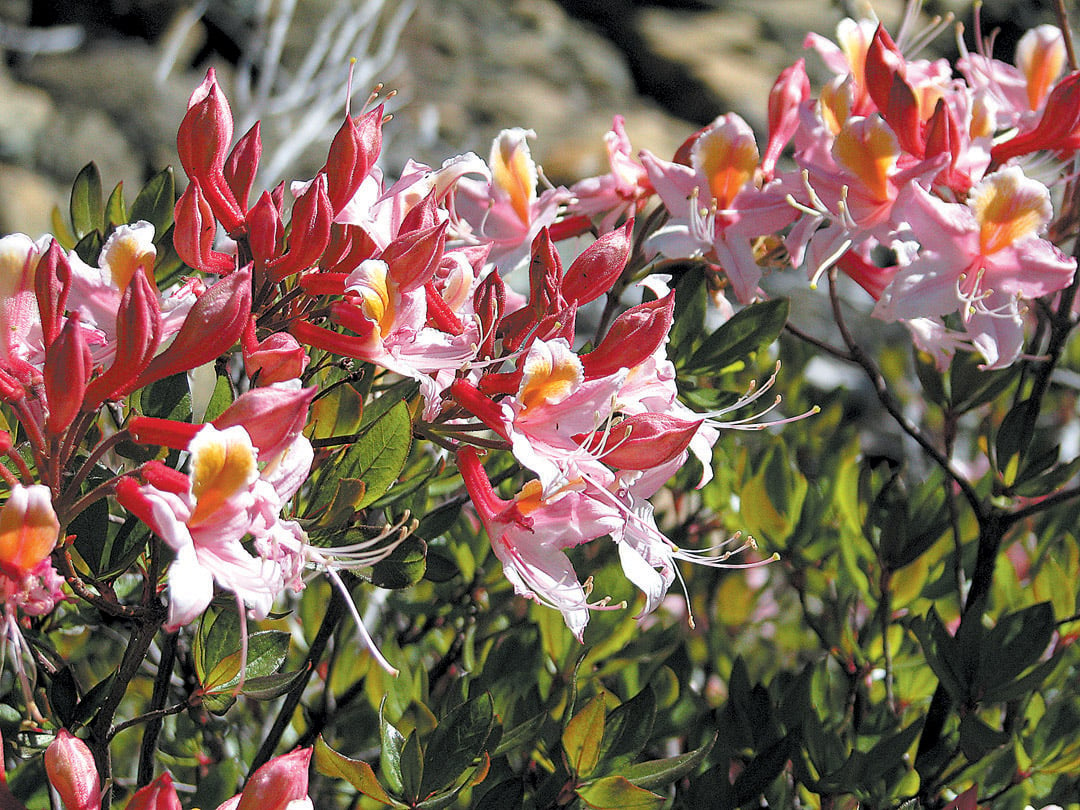Western Azalea: The
Title: Western Azalea: The Rose Tree of the Western Sky
Introduction:
Western azalea (Rhododendron occidentale) is a deciduous shrub native to the western United States. It is found in moist forests and woodlands from California to Washington. Western azalea can grow up to 10 feet tall and wide. It has dark green leaves that are oval-shaped and up to 4 inches long. In the spring, Western azalea blooms with showy clusters of pink, purple, or white flowers. The flowers are fragrant and attract butterflies and hummingbirds.
Western azalea is a popular ornamental shrub and is often used in gardens and landscaping. It is relatively easy to care for and can tolerate a variety of soil conditions. However, Western azalea does not like hot, dry weather and should be planted in a location that receives partial shade.
Main Content:
- History and Etymology
The western azalea was first described by botanist David Douglas in 1827. The species name, occidentale, means "of the west" in Latin. The common name "azalea" comes from the Greek word "azalēa," which means "unfading."
- Distribution and Habitat
Western azalea is native to the western United States. It is found in moist forests and woodlands from California to Washington. The plant is most common in the coastal ranges, but it can also be found in the Cascade and Sierra Nevada mountain ranges.
- Description
Western azalea is a deciduous shrub that can grow up to 10 feet tall and wide. The leaves are dark green and oval-shaped, up to 4 inches long. The flowers are fragrant and bloom in the spring. The flowers can be pink, purple, or white, and they are often marked with a yellow or orange blotch.
- Cultivation
Western azalea is relatively easy to care for. It prefers moist, acidic soil and partial shade. The plant should be watered regularly, especially during the summer months. Western azalea is also susceptible to pests and diseases, so it is important to monitor the plant for signs of problems.
- Uses
Western azalea is a popular ornamental shrub and is often used in gardens and landscaping. The plant can also be used as a cut flower. Western azalea is also a host plant for several butterfly species.
Conclusion:
Western azalea is a beautiful and fragrant shrub that is native to the western United States. The plant is relatively easy to care for and can be grown in a variety of settings. Western azalea is a valuable addition to any garden or landscape.
Western azalea (Rhododendron occidentale) is a beautiful and fragrant deciduous shrub native to western North America. It is known for its large, showy white flowers that bloom in late spring to early summer. Western azalea is also relatively easy to care for, making it a popular choice for home gardeners.
If you are interested in learning more about western azalea, please visit Home Gardening. This website provides detailed information about the plant's history, cultivation, and care. You can also find photos, videos, and articles about western azalea on this website.
FAQ of western azalea
- What are western azaleas?
Western azaleas are a type of flowering shrub that is native to western North America. They are characterized by their showy flowers, which come in a variety of colors, including pink, red, white, and purple. Western azaleas are typically evergreen, but some varieties may be deciduous.
- Where do western azaleas grow best?
Western azaleas prefer to grow in moist, well-drained soil in partial to full shade. They are not tolerant of hot, dry climates.
- How do I care for western azaleas?
Western azaleas need regular watering, especially during the spring and summer months. They should also be fertilized once a year in the spring. To help keep the roots cool and moist, mulch around the base of the plant with pine needles or bark.
- What are some common problems that western azaleas face?
Western azaleas are susceptible to a number of pests and diseases, including aphids, scale insects, and azalea leaf spot. They may also be affected by root rot if they are planted in poorly drained soil.
- How do I propagate western azaleas?
Western azaleas can be propagated by cuttings or division. Cuttings should be taken in the spring or summer from healthy, non-flowering stems. Division can be done in the spring or fall.
- How long do western azaleas live?
Western azaleas can live for many years, with some specimens living for over 100 years.
Image of western azalea
- A close-up of a single western azalea flower. The flower is light pink with a yellow blotch at the base.

- A cluster of western azalea flowers in bloom. The flowers are a variety of colors, including pink, white, and purple.

- A western azalea shrub in full bloom. The shrub is covered in flowers, and the leaves are a dark green.

- A western azalea tree in full bloom. The tree is tall and slender, and it is covered in flowers.

- A western azalea growing in a forest. The azalea is surrounded by other trees and plants, and the flowers are a bright pink color.

- A western azalea in a garden. The azalea is planted in a flower bed, and it is surrounded by other flowers.

- A western azalea in a vase. The azalea has been cut and is now in a vase, and the flowers are still blooming.
- A western azalea in a painting. The painting is of a western azalea in full bloom, and the colors are very vibrant.

- A western azalea in a photo. The photo is of a western azalea in full bloom, and the flowers are a beautiful shade of pink.

- A western azalea in a 3D render. The render is of a western azalea in full bloom, and the flowers look very realistic.


Post a Comment for "Western Azalea: The"